Louisville, Tennessee
By Ingrid Spencer-via:archrecord
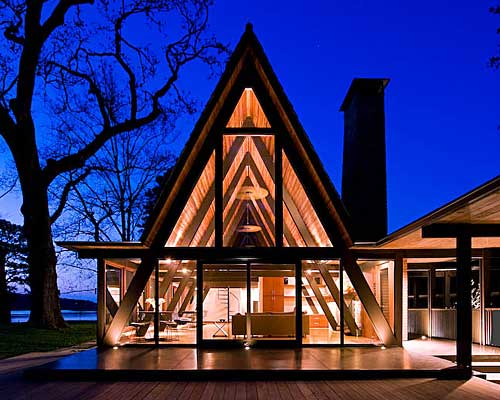
Photo © Robert Batey Photography
Some projects are more intensely personal than others. The Weeks House, in Louisville, Tennessee, renovated by Brian Pittman, Assoc. AIA, is one of those. For Paul and Jeannine Weeks, who were living in Connecticut and working for a pharmaceutical company, renovating this house meant recreating a dwelling that was built and designed in 1950 by Paul’s father, Felder Weeks, AIA, and making it their retirement refuge. “Felder Weeks had five children, and all of them cherished this house,” says Pittman. Paul Weeks agrees, “I could talk about this house for hours.” For Pittman, who was going through a divorce at the time, the project was the perfect outlet into which to channel all his energy after coming home from his day job as a designer with Knoxville firm McCarty Holsaple McCarty. Pittman and the Weekses were all committed to making this project sing.
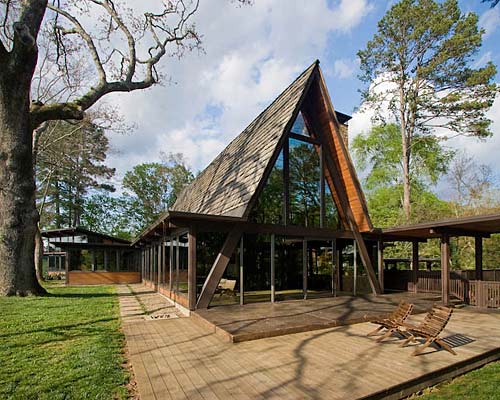
Photo © Robert Batey Photography
The late Felder Weeks bought the one-and-a-third acre plot of land in 1950 for $750. He recognized the value of the property, on a peninsula on the Tennessee River, and knew that though it seemed remote at the time, it was destined to change. It is now about a 30-minute drive from Knoxville. The A-frame house, at 1,656 square feet with three tiny bedrooms and one bath downstairs and a loft bedroom upstairs, was built as a vacation place, and not somewhere to retire and live year-round. “Jeannine and I suffered from a fatal disease,” Paul says, “It’s called ‘final house syndrome.’ We bought the home from my parents and when my father died and my mom moved to a condo in town, we had to make this house into one we could spend the rest of our lives in.” 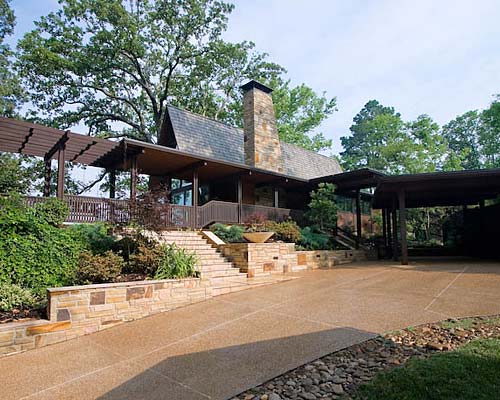
Photo © Robert Batey Photography
Paul went to his father’s former business partner, 88-year-old Bruce McCarty, FAIA, who still runs and works (when he wants to) for his firm. McCarty handed the job to Pittman, his associate, to do outside the office, but with his oversight. “Bruce knew I needed something to keep me going,” says Pittman, “and he also knew that I would work to preserve the integrity of Felder Weeks’s vision with this house.” The Weekses agreed, and with McCarty as mentor, the two-year-long renovation went ahead. 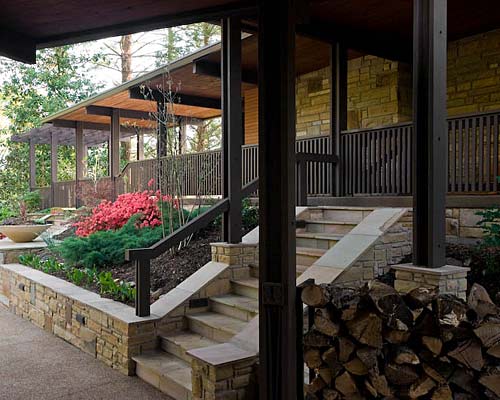
Photo © Robert Batey Photography
The results are a 3,200-square-foot renovation and expansion, including a covered porch and a 544-square-foot guesthouse. The house was essentially gutted down to the original structure and concrete slab foundation. The recently re-shingled cedar-shake roof was also preserved. The Douglas fir original structural elements were built on and expanded with polished concrete inside and out, local crab orchard stone, cork flooring over the original concrete, cedar siding, fir millwork, a spiral staircase to the loft, and ipe decks outside. “We like a sense of uncluttered space and natural materials,” says Paul, admitting that this might be a trait he inherited from his father. Pittman and the team kept the house true to that aesthetic. Spaces were reconfigured and expanded: the size of the kitchen was doubled, sacrificing one of the original bedrooms enlarged the one bathroom downstairs, and an original closet was reoriented to make way for a small study and large closet for the new master bedroom suite. The living room was enlarged by a third, walled on three sides in glass, and a mud room/laundry area added. Built-ins abound in every area of the house, with ash cabinets and shelves throughout, and a built-in ash bed and desk in the master bedroom. “We hardly have any furniture in the house,” says Paul. “We don’t need it. But most of what we do have is what my dad put here 50 years ago.” Those pieces include 14 original Bertoia wire frame side chairs, a Bertoia bird chair, and an Eames lounge chair. A built-in table that seats seven was restored and holds the same spot in the dining area that it did 50 years ago. Completing the project, a guesthouse with full bath, kitchenette, and basement was built at the end of a covered walkway that extends from the mudroom of the main house. 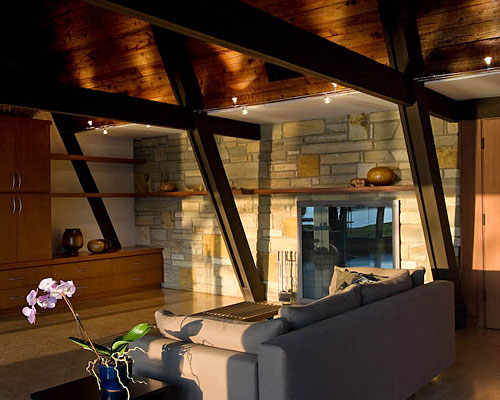
Photo © Robert Batey Photography
For the Weekses, who have two grown children who live out of state, there’s not a part of the house that they don’t use (“except for the loft,” says Paul, “which is my mother’s and the cat’s. And yes, my 87-year-old mother can get up and down that spiral staircase really well!”), and family reunions have become rather large events. “My parents also owned an adjoining property,” says Paul, “and my four sisters bought that and built what we call the Sister House. It’s empty most of the time, but when they all converge for reunions with their families it can be quite a busy time.” Paul says those reunions aren’t all that frequent, so most of his and Jeannine’s time is spent enjoying their home and its surroundings. “Watching the barges going down the river, fly fishing, just relaxing in this beautiful house, it’s been astounding,” says Paul. Some projects, it seems, bring catharsis for both client and designer. “It was a labor of love for everyone involved,” says Pittman. “And these clients weren’t afraid of anything but wasting money. Everything we did felt right, and still does.” 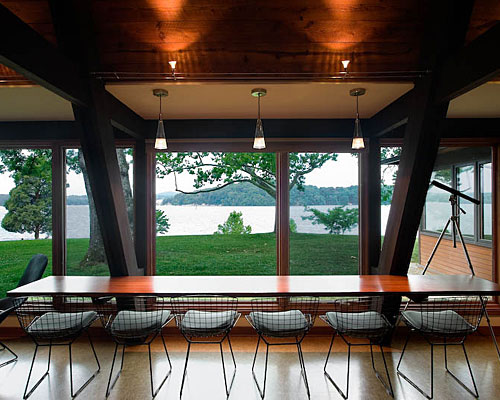
Photo © Robert Batey Photography

Photo © Robert Batey Photography
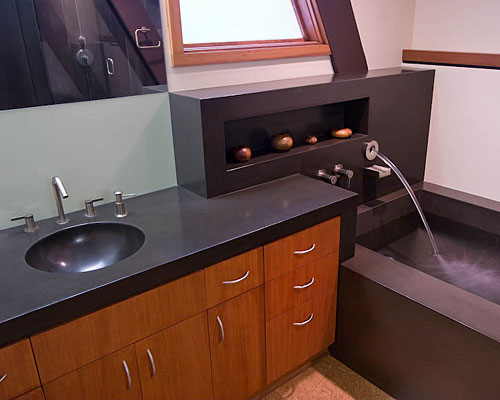
Photo © Robert Batey Photography
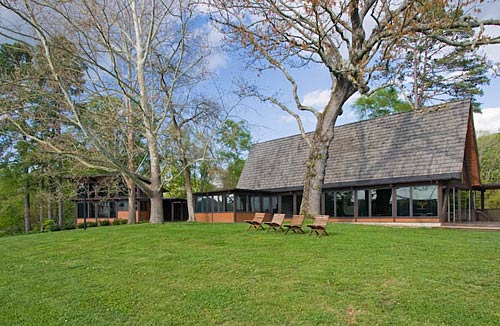
Photo © Robert Batey Photography
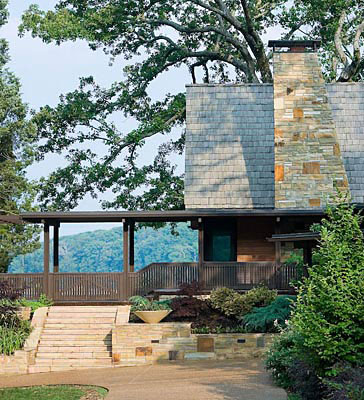
Photo © Robert Batey Photography
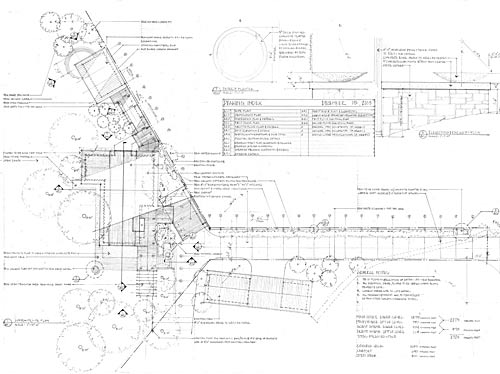
Image courtesy McCarty Holsaple McCarty, Inc